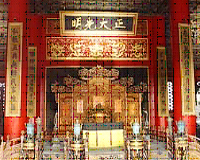Forbidden City
The Forbidden City, dominating the heart of the city, is a range of well-preserved palace architecture of the Ming and Qing dynasties. Since then there were 26 emperors of Ming and Qing dynasties ruled from the Forbidden City for over 500 years, it is the largest piece of ancient Chinese architecture still standing.
is a range of well-preserved palace architecture of the Ming and Qing dynasties. Since then there were 26 emperors of Ming and Qing dynasties ruled from the Forbidden City for over 500 years, it is the largest piece of ancient Chinese architecture still standing.
The original palaces were constructed during the Ming period (1368 - 1644) over 560 years ago and the present complex was the result of several extensions in the Qing Dynasty (1644 - 1911).
The city covers 720,000 square meters and has a building area of 160,000 square meters, more than 9,000 constructions palaces. Wumen (Meridian Gate) is the main entrance for most visitors to the Forbidden City.
 Since yellow is the symbol of the royal family, it is the dominant color in the Forbidden City. Roofs are built with yellow glazed tiles; decorations in the palace are painted yellow; even the bricks on the ground are made yellow by a special process. However, there is one exception. Wenyuange, the royal library, has a black roof. The reason is that it was believed black represented water then and could extinguish fire.
Since yellow is the symbol of the royal family, it is the dominant color in the Forbidden City. Roofs are built with yellow glazed tiles; decorations in the palace are painted yellow; even the bricks on the ground are made yellow by a special process. However, there is one exception. Wenyuange, the royal library, has a black roof. The reason is that it was believed black represented water then and could extinguish fire.
Now the Forbidden City is the greatest and the most complex ancient palace in China and the world. Now it is the palace museum. Listed by UNESCO as a World Cultural Heritage Site in 1987, the Palace Museum is now one of the most popular tourist attractions worldwide.